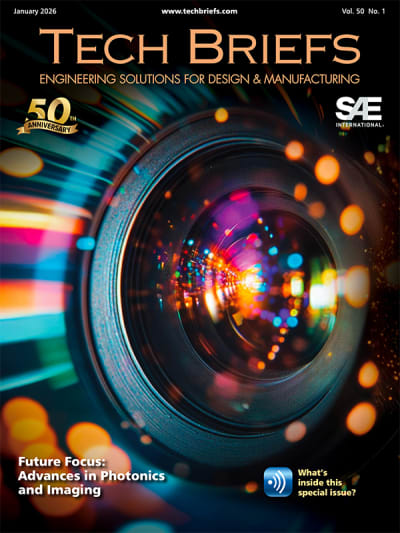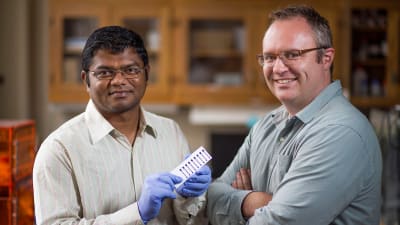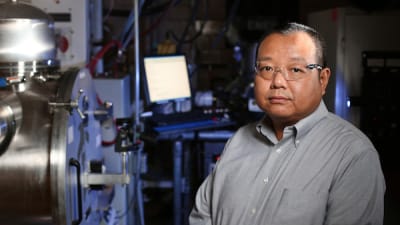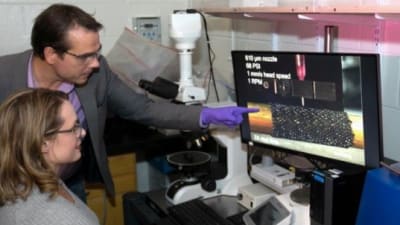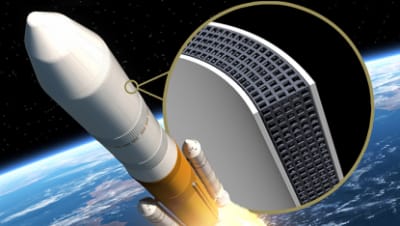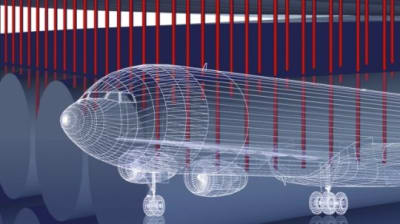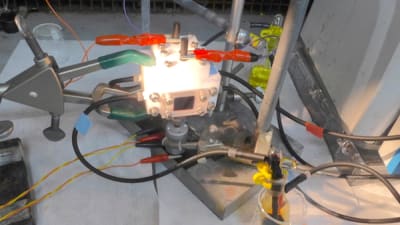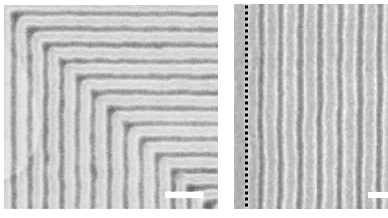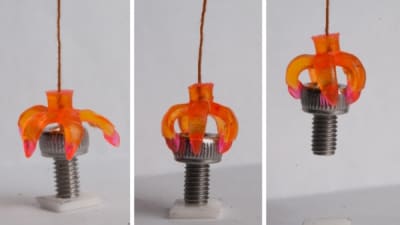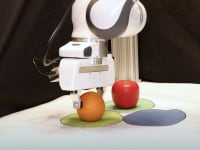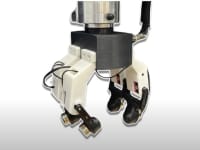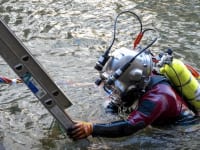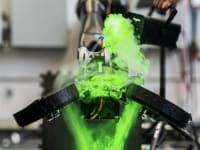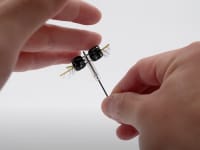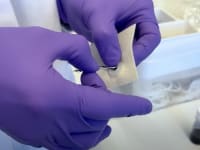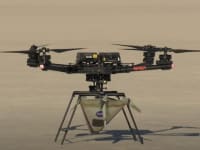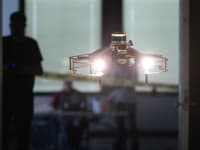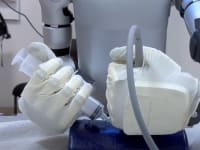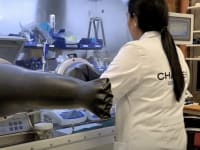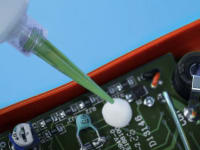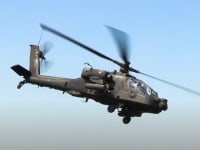61
12,105,170,194,926
-1
2130
30
INSIDER: Imaging
New Scanning Method Speeds Up 3D Printing
Penn State University researchers have used a beam deflector to increase the speed of 2D and 3D printing by up to 1000 times.
INSIDER: Materials
Flexible Solar Panels Absorb Diffused Light
Virginia Tech researchers have produced flexible solar panels that can become part of window shades or wallpaper. The material will capture light from the sun as well as light from sources inside buildings.
Question of the Week: Aerospace
Will we see a flying car transportation service?
This week’s Question: Ride-hailing company Uber recently released a white paper outlining its new transport service: the flying car. The company envisions a “network of small, electric aircraft that take off and land vertically.” The proposal aims to use airspace to relieve transportation...
News: Medical
By using lasers to treat graphene, Iowa State University researchers have found new ways to enable flexible, wearable, and low-cost electronics. Fabricating inkjet-printed, multi-layer graphene...
INSIDER: Imaging
Researchers Make Full-Color Holograms from Nanomaterials
Imagine cell phones with 3D floating displays, or credit cards with three-dimensional security markings.
By using just one layer of nanoscale metallic film, researchers at Missouri University of Science and Technology have reconstructed 3D full-color holographic images. The technique supports...
Question of the Week: Robotics, Automation & Control
Will artificial intelligence do more good than bad for humanity?
This week's Question: World-famous physicist Stephen Hawking recently warned that the creation of powerful artificial intelligence will be “either the best, or the worst thing, ever to happen to humanity.” Hawking noted the risks of creating superintelligence with a will of its...
INSIDER: Robotics, Automation & Control
The SIMbot robot features an elegant motor with just one moving part: the ball. The only other active moving part of the robot is the body itself. A spherical induction motor...
INSIDER: Motion Control
In order to make plug-in electric vehicles as affordable and convenient as internal-combustion cars, their motors must be smaller, lighter, more powerful, and more cost-effective. A research team is...
INSIDER: Sensors/Data Acquisition
New System Allows Buildings to 'Sense' Internal Damage
Researchers at the Massachusetts Institute of Technology have developed a computational model that makes sense of the ambient vibrations that travel up a structure as trucks and other forces rumble by. By picking out specific features in the noise that give indications of a building’s...
News: Manufacturing & Prototyping
A team of Lawrence Livermore National Laboratory researchers have demonstrated the 3D printing of shape-shifting structures that can fold or unfold to reshape themselves when exposed to heat...
News: Aerospace
Strong vibrations from a bus engine can be felt uncomfortably through the seats. Similarly, vibrations from the propellers or rotors in propeller aircraft and helicopters can make the flight bumpy and loud....
News: Aerospace
The newest Airbus and Boeing passenger jets flying today are made primarily from advanced composite materials such as carbon fiber reinforced plastic – extremely light, durable...
INSIDER: Robotics, Automation & Control
‘Robomussels’ Monitor Climate Change
Northeastern University scientist Brian Helmuth and other researchers have developed "robomussels" that monitor climate change. The tiny devices have miniature built-in sensor that track temperatures inside the mussel beds.
Question of the Week: Software
Can algorithms create a pop-music hit?
This week's Question: Sony Computer Science Laboratory (CSL) in Paris is developing a system of algorithms which can create songs that cater to the user's taste, based on styles adapted from existing music. Starting with a sheet-music database of more than 13,000 existing songs, users choose several titles...
INSIDER: Nanotechnology
Researchers have created an exotic 3-D racetrack for electrons in ultrathin slices of a nanomaterial they fabricated at the Department of Energy’s Lawrence Berkeley...
INSIDER: Electronics & Computers
Researchers studying the behavior of nanoscale materials at the Department of Energy’s Oak Ridge National Laboratory have uncovered remarkable behavior that could advance microprocessors...
INSIDER: Electronics & Computers
Researchers at North Carolina State University have developed new, nonlinear, chaos-based integrated circuits that enable computer chips to perform multiple functions with...
INSIDER: Photonics/Optics
As solar cells produce a greater proportion of total electric power, a fundamental limitation remains: the dark of night when solar cells go to sleep. Lithium-ion batteries, the commonplace...
INSIDER: Photonics/Optics
From hard to malleable, from transparent to opaque, from channeling electricity to blocking it: materials come in all types. A number of their intriguing properties...
INSIDER: Sensors/Data Acquisition
Through a collaboration between the University of Calgary, The City of Calgary and researchers in the United States, a group of physicists led by Wolfgang Tittel, professor in the...
INSIDER: Robotics, Automation & Control
3D-Printed Robots Feature Shock-Absorbing Skins
A “programmable viscoelastic material” (PVM) from the Massachusetts Institute of Technology (MIT) allows users to program every single part of a 3D-printed object, including exact levels of stiffness and elasticity.
Question of the Week: Software
Will selfies become the primary mode of authentication?
This week's Question: MasterCard has tested facial biometrics for payment authentication and has now begun rolling out its MasterCard Identity Check, or "selfie pay," to a greater number of users. The biometric authentication app is available throughout Europe, including Austria, Belgium, the...
INSIDER: Electronics & Computers
Researchers Create Smallest Transistor Ever
A research team led by faculty scientist Ali Javey at the Department of Energy’s Lawrence Berkeley National Laboratory (Berkeley Lab) has created a transistor with a working 1-nanometer gate — the smallest to date.
INSIDER: Imaging
Researchers Propose Modular Space Telescope
Researchers from California Institute of Technology are proposing the idea of a modular space telescope that could be assembled by robots. The space observatory would have a primary mirror with a diameter of 100 meters — 40 times larger than the Hubble Space Telescope.
Question of the Week: Energy
Will solar road panels catch on?
This week's Question: Solar Roadways — a startup developing solar powered road panels — will soon install the first solar road tiles in Sandpoint, Idaho. The transparent solar road panels contain colorful LEDs, which can be controlled by a computer to create the impression of signs and lines, without the need of...
INSIDER: Propulsion
Large elements for NASA's Space Launch System are in production, and will be joined together to create the rocket's 212-foot-tall core stage, the backbone of the SLS rocket. The core...
INSIDER: Electronics & Computers
Engineers have devised a simple, reproducible, and less expensive approach to manufacturing computer chips using directed self-assembly, which can increase the density of circuit...
INSIDER: Materials
Engineers are using light to print three-dimensional structures that “remember” their original shapes. The process of 3D printing shape-memory materials can also be thought...
Question of the Week
Will ground-based delivery robots catch on?
This week's Question: This fall, Starship Technologies, an Estonia-based startup created by two Skype co-founders, will begin testing its autonomous delivery robot in Washington, D.C. Washington is the first U.S. municipality to approve ground-based robots to traverse city sidewalks. Starship aims to...
Top Stories
Blog: Manufacturing & Prototyping
2025 Holiday Gift Guide for Engineers: Tech, Tools, and Gadgets
INSIDER: Research Lab
Scientists Create Superconducting Semiconductor Material
Blog: Software
Quiz: Materials
Blog: Aerospace
Tech Briefs Wrapped 2025: Top 10 Technology Stories
Blog: Manufacturing & Prototyping
Webcasts
 Upcoming Webinars: AR/AI
Upcoming Webinars: AR/AI
The Real Impact of AR and AI in the Industrial Equipment Industry
 Upcoming Webinars: Motion Control
Upcoming Webinars: Motion Control
Next-Generation Linear and Rotary Stages: When Ultra Precision...
 Upcoming Webinars: Energy
Upcoming Webinars: Energy
Hydrogen Engines Are Heating Up for Heavy Duty
 Podcasts: Medical
Podcasts: Medical
How Wearables Are Enhancing Smart Drug Delivery
 Podcasts: Power
Podcasts: Power
SAE Automotive Podcast: Solid-State Batteries
